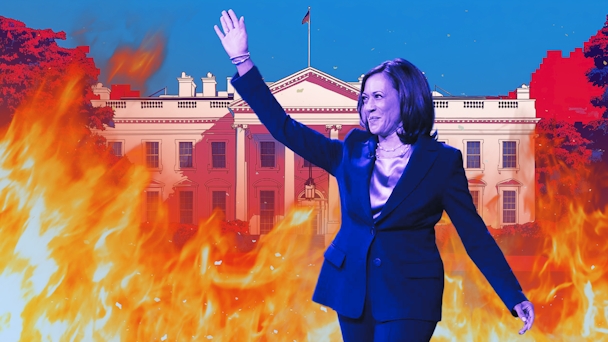It was never a neck-and-neck race. Where did the Harris campaign lose the plot?
Voters’ economic discontent, paired with Harris’ failure to distinguish herself meaningfully from either her predecessor or her opponent, ultimately sank the Democrats’ dreams of securing the White House.

Harris lost the US presidency to Republican candidate Donald Trump in a shocking and spectacular defeat / Kendra Barnett
What went wrong in Kamala Harris’ bid for the presidency?
The Vice President and Democratic nominee lost the US presidency in a spectacular flop Wednesday morning as her rival, former President and convicted felon Donald Trump, clinched majorities in key battleground states including Wisconsin and Pennsylvania.
Not only did Trump secure the electoral college votes needed to send him to the White House; he also won the popular vote – the first time a Republican has done so since 2004, when George W. Bush eked out 50.7% to John Kerry’s 48.3%.
It was a shocking defeat for Harris, who stepped up to lead the Democratic ticket in July after President Joe Biden’s late exit from the race.
In the weeks and days leading up to the election on November 5, polling data suggested the race was neck-and-neck in seven swing states that could help determine the outcome – Wisconsin, Pennsylvania, Michigan, Georgia, Nevada, Arizona and North Carolina. But the results evidenced a much more decisive electorate. Trump didn’t just win – he won big. He flipped Wisconsin, Pennsylvania and Georgia, all of which went blue in 2020. Meanwhile, Republicans swept the Senate, too. At the time of publishing, control of the House remains unclear as ballot counts continue.
Polling has always been a blunt instrument incapable of capturing a truly representative picture of the electorate – but how did the experts get this one so wrong?
“Pollsters for the last several cycles have been trying to figure out what types of survey methods and techniques to use, and they just haven’t been able to get that right,” says Dr. Tobe Berkovitz, a former political consultant and an associate professor emeritus at Boston University who specializes in political advertising and communications. “What’s the combination of telephone, of mobile phone, of internet, of social media? How do you come up with a way to reach voters that is representative and valid?”
Another shortcoming is low response rates, in combination with skewed demographics. Most public opinion polls have fairly low response rates. Those who do participate are disproportionately white and educated, compared with the average voter, according to data from Pew Research Center and YouGov. As the demographic makeup of the country shifts, the extent to which these polls fail to accurately reflect the country’s diversity comes into sharper relief.
This may help explain some of the polling shortcomings of the 2024 race – and why Harris’ camp was the one blindsided. “The biggest shift seen over the past decade has been among lesser educated individuals, especially younger men, who have voted for Trump and Republican candidates in record numbers,” says Michael D. Worley, founder and senior partner at MDW Communications, a leading political marketing agency.
While poor polling can be blamed, at least in part, for the shock and awe that has rocked the country over the last 12-plus hours, bad estimates of course aren’t to blame for Harris’ defeat.
Her loss, experts say, boils down to a combination of factors – economic discontent among the electorate, political factors like her association with President Biden and a smattering of campaign and messaging missteps.
Want to go deeper? Ask The Drum
Economic discontent rears its head
Perhaps the biggest piece in the puzzle is Americans’ widespread economic grievances. Although inflation is simmering down on the heels of interest rate cuts and the national unemployment rate remains low, many voters are disillusioned with the current administration as a result of their personal experiences. Pre-election polling found that many voters cited rising living costs as a major pain point. Americans are still paying more at the grocery store and at the gas pump than they were a few years ago, for example – data from the Bureau of Labor Statistics indicates that prices are, on average, 21% higher than they were pre-pandemic. And in October, just 12,000 jobs were added to the US market, well below the forecasted 100,000.
In Worley’s view, voters’ perceptions about the economy served as “the ultimate downfall” for Harris.
“Things cost a whole lot more than they did before President Biden came into the office,” he says. “Anyone with a brain knows that this is a result of the Covid crisis, and the stimulus that helped keep the world from collapsing under the weight of that once-in-a-century catastrophe. Inflation was the price we paid. But it is very difficult to campaign on improving the economy when you were a part of the incumbent administration that was in power during this period of economic hardship.”
While Harris shouldn’t bear the brunt of the blame for the country’s economic woes during and after the pandemic, Worley says, it was “easy” for Republicans to use the state of the economy as “fodder in their ad war against her.”
Harris’ economic record and policies were focal points in a handful of attack ads levied by the Trump campaign. At the end of last month, Trump shared a new campaign ad on Instagram and X claiming that Harris “was the deciding vote for [Biden’s] disastrous economic agenda” and helped raise taxes on middle-class Americans. The ad cherry-picked an excerpt from a New York Times report – the full text of which did not support this latter claim.
Nonetheless, many voters perceive Donald Trump as stronger on the economy than Kamala Harris.
Advertisement
The Biden lookalike problem
Republicans didn’t just seize on voters’ economic worries to tie Vice President Harris to President Biden’s agenda. In a consistent messaging strategy, the Trump campaign sought to paint Harris and Biden as politically inseparable, framing them as a single, unified front on a variety of contentious issues.
And Harris didn’t do herself many favors on this front. In an interview on ABC’s The View in October, she was asked to explain what she’d do differently in office than President Biden. “Not a thing that comes to mind,” Harris said.
On the campaign trail, Harris “[wasn’t] effective in navigating the balance between taking credit for the positive things that the administration did and distancing herself from other parts of Biden’s record,” says Dr. Jacob Neiheisel, an associate professor of political science at University of Buffalo and an expert in public comms.
Ultimately, the Vice President was not able to effectively position herself as a ‘change’ candidate. And being politically indistinct from a president with a low likeability – Biden’s approval ratings have stood around 40% for the last two years – was a damning fate in the end.
Advertisement
Campaign missteps that took a toll
Harris’ broader marketing and messaging strategies fell flat, too, according to some experts.
The Vice President, who ran alongside Minnesota governor Tim Walz, focused on framing former President Donald Trump as a threat to democracy, drawing on his past actions and rhetoric. But this was not news to most voters – so it was wasted breath, says Berkovitz.
“[Democrats] should have learned from 2016 – and Hillary Clinton’s campaign – that you can’t beat Donald Trump by beating on Donald Trump constantly. That was what Hillary did, and that’s what Harris did,” he says. “It’s like water off the back of a duck. The public knows everything that’s wrong with Donald Trump. So to spend all of your time saying, ‘He’s a fascist,’ and saying, ‘He’s a threat to democracy,’ well, that’s already baked [into the minds of] 48% of the public. The swing voters needed to hear, ‘What are you going to do about what concerns me?’”
It’s an assessment echoed by other experts, including pollster Frank Luntz. In a post on X early Wednesday morning, Luntz wrote: “Voters already know everything there is about Trump – but they still wanted to know more about Harris’ plans for the first hour, first day, first month and first year of her administration. It was a colossal failure for her campaign to shine the spotlight on Trump more than on Harris’ own ideas.”
Kamala Harris lost this election when she pivoted to focus almost exclusively on attacking Donald Trump.
Voters already know everything there is about Trump – but they still wanted to know more about Harris’ plans for the first hour, first day, first month and first year of her… https://t.co/uCCl4WCykh
— Frank Luntz (@FrankLuntz) November 6, 2024
Suggested newsletters for you
Many voters were seeking more concrete policy proposals from Harris. On a small selection of issues, like abortion, she delivered a clear and resonant message. But on many other issues – ranging from immigration and the economy to foreign policy – Harris was fairly unclear in her attempts to communicate tangible plans.
In a similar vein, Harris would have done well to prioritize positive messaging – rather than framing her campaign as a referendum on Trump, Berkovitz suggests. “She needed to do much more of the positive messaging.”
Stagwell CEO and former Hillary Clinton campaign strategist Mark Penn has said much the same.
Lost ground among Latino, Black and working-class voters
Based on the voter data coming out of Election Day, Democrats also woefully miscalculated some areas of critical support.
Harris fell flat with a number of historically strong Democratic constituencies. She struggled to match Biden’s 2020 performance with Black and Latino voters, winning 86% of the Black vote compared to Biden’s 92% and just 53% of Latino voters compared to Biden’s 65%, according to exit polls. Plus, a shift toward Trump was seen across educational backgrounds, but the most significant gains came from minority voters without college degrees, according to data from AP VoteCast.
Narrow margins in hotly contested states like Pennsylvania created an opening for Donald Trump to reclaim vital electoral territory that Democrats had relied upon in recent cycles.
Meanwhile, Donald Trump’s 2024 campaign helped solidify the Republican Party’s shift toward a more racially diverse working-class base, expanding on the realignment he began in 2016.
All together, the evidence underscores a harsh truth for Democrats: regaining lost ground with minority and working-class voters will require an overhaul in their approach.
“Democrats have long believed that ‘demographics are destiny’ and that a more diverse electorate is one that will favor them. That idea is looking increasingly tenuous right now if the exit polls are at all accurate,” says Neiheisel.
MDW’s Worley suggests that refocusing on connecting with blue-collar voters should be top-of-mind for Democrats moving forward. “The backbone of the Democratic coalition for many years was the working class and union members. We need to make them the focus once again,” he says. “This means putting culture wars aside and focusing on how we can make life better for the vast majority of Americans who live paycheck to paycheck and just want to give their kids a better future.”
In the end, Harris’ inability to create a clear and compelling break from Biden’s record – compounded by voters’ economic discontent and campaign missteps – likely led to Harris’ demise at a time when the American populous is pining for substantial change.
In Neiheisel’s telling, “there might be some soul-searching going on right now” in the Democratic party.
For more, sign up for The Drum’s daily newsletter here.
